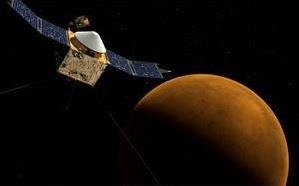November 15, 2013
WASHINGTON: Ancient Mars likely had a thick atmosphere that was warm enough to support oceans of liquid water, a critical ingredient for life, according to Nasa.

Nasa's Mars Atmosphere and Volatile Evolution (MAVEN) mission, which launches this month and is likely to arrive at Mars in September 2014, will investigate how Mars lost its atmosphere.
November 15, 2013
WASHINGTON: Ancient Mars likely had a thick atmosphere that was warm enough to support oceans of liquid water, a critical ingredient for life, according to Nasa.

Nasa's Mars Atmosphere and Volatile Evolution (MAVEN) mission, which launches this month and is likely to arrive at Mars in September 2014, will investigate how Mars lost its atmosphere.
MAVEN will investigate the dramatic climate change that took place on Mars. That process of change has been rendered by sophisticated computer animation in a video.
Today, Mars is a cold and barren desert world, with no sign of life, at least on the surface.
However, billions of years ago when the Red Planet was young, it appears to have had a thick atmosphere that was warm enough to support oceans of liquid water – a critical ingredient for life.
The video shows as time passes, the lakes dry up or freeze and the blue skies turn to the dusty pink and brown of today's Red Planet.
Study of Mars's surface features and mineral compositions suggest that ancient Mars had a denser atmosphere and vast surface water, according to Joseph Grebowsky at Nasa's Goddard Space Flight Center in Greenbelt.
"There are characteristic dendritic structured channels that, like on Earth, are consistent with surface erosion by water flows. The interiors of some impact craters have basins suggesting crater lakes, with many showing connecting channels consistent with water flows into and out of the crater. Small impact craters have been removed with time and larger craters show signs of erosion by water before 3.7 billion years ago," says Grebowsky.
"The leading theory is that Mars lost its intrinsic magnetic field that was protecting the atmosphere from direct erosion by the impact of the solar wind," said Grebowsky.
MAVEN will also work with other missions to try to determine if hospitable conditions on Mars lasted long enough to have supported life.
Courtesy: PTI







































































































